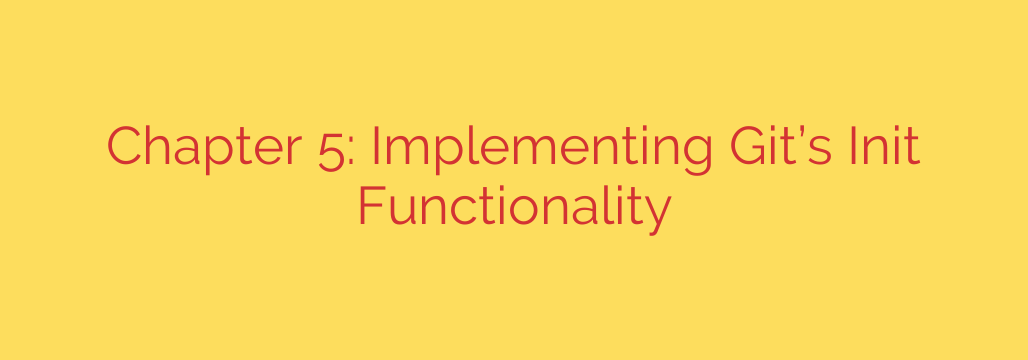
What Does git init Really Do? A Look Under the Hood
For most developers, git init is the very first command typed when starting a new project. It’s the magical incantation that turns an ordinary folder into a powerful, version-controlled repository. But what actually happens behind the scenes? Understanding the mechanics of this fundamental command is the key to mastering Git and troubleshooting issues with confidence.
While it seems simple, git init is responsible for building the entire framework that Git uses to track your project’s history. It doesn’t just create a hidden folder; it sets up a carefully organized structure of files and directories that serve as the brain of your repository. Let’s break down exactly what gets created and why each piece is essential.
The Birth of the .git Directory
When you run git init in your project folder, Git creates a new, hidden subdirectory named .git. This directory is the heart of your repository. Everything Git needs to manage your project—all the history, branches, tags, and configuration—is stored inside this single folder. If you delete the .git directory, you remove all version control history from your project, leaving you with just the current working files.
The structure of the .git directory is standardized and reveals how Git operates at a low level. The most critical components created by git init are the objects directory, the refs directory, and the HEAD file.
1. The Object Database: The objects Directory
The objects directory is arguably the most important part of a Git repository. This is where Git stores all your data. However, it doesn’t just store copies of your files. Instead, it maintains an object database containing four types of objects:
- Blobs: These store the raw contents of your files. Every version of every file you commit is stored as a blob. Git uses the file’s content to generate a unique SHA-1 hash, which serves as the blob’s name.
- Trees: A tree object represents a directory. It contains a list of blobs (files) and other trees (subdirectories) that make up a single snapshot of your project at a specific point in time.
- Commits: A commit object points to a single tree object, representing the state of your project at the time of the commit. It also contains metadata like the author, committer, date, and commit message, as well as pointers to one or more parent commits.
- Tags: A tag object points to a specific commit, marking it as important (e.g., a version release like
v1.0).
Initially, the objects directory is nearly empty, only containing a couple of placeholder subdirectories (pack and info). As you add and commit files, Git will begin populating this directory with the objects that represent your project’s history.
2. The Pointers: The refs Directory
If the objects directory is the database, the refs directory is the index. It contains references, or pointers, to specific commit objects. These references are what we commonly know as branches and tags, making it easy to refer to specific points in your project’s history without having to memorize long SHA-1 hashes.
Inside refs, you’ll find two key subdirectories:
refs/heads: This directory is where your local branches are stored. When you create a new branch, sayfeature-login, Git creates a file at.git/refs/heads/feature-login. This file contains the 40-character SHA-1 hash of the latest commit on that branch.refs/tags: This is where your tags are stored. Similar to branches, each file in this directory is named after a tag and contains the SHA-1 hash of the commit it points to.
By using simple files to store these pointers, Git provides a lightweight and incredibly efficient way to manage branches and tags.
3. The Current Position: The HEAD File
So, if refs/heads stores all the branches, how does Git know which branch you are currently working on? That’s the job of the HEAD file.
The HEAD file is a symbolic reference that points to the branch you have currently checked out. If you open the .git/HEAD file in a text editor, you will see something like this:
ref: refs/heads/main
This line tells Git that HEAD is currently pointing to the main branch. When you make a new commit, Git knows to update the main branch reference (the file at .git/refs/heads/main) to point to the new commit’s SHA-1 hash. If you were to switch branches using git checkout develop, the content of the HEAD file would change to ref: refs/heads/develop.
This simple mechanism is what allows you to move between different points in your project’s history seamlessly.
Actionable Best Practices
Understanding how git init works empowers you to use Git more effectively. Here are a few key takeaways and tips:
- Initialize at the Root: Always run
git initin the top-level directory of your project. This ensures the entire project is contained within a single repository. - Never Manually Edit the
.gitDirectory: Unless you are an expert and know exactly what you are doing, avoid making manual changes inside the.gitfolder. A wrong move could corrupt your entire repository history. - Consider a Bare Repository for Servers: If you’re setting up a central repository for collaboration (like on a server), use the command
git init --bare. This creates a repository without a working directory, containing only the contents of the.gitfolder. This is the standard for creating shared, remote repositories that developers can push to and pull from.
In conclusion, git init does much more than create a hidden folder. It constructs a robust and efficient system for tracking changes by establishing an object database, a system for references (branches and tags), and a pointer for your current location (HEAD). By building this foundation, git init prepares your project for powerful version control, setting the stage for every add, commit, and push to come.
Source: https://linuxhandbook.com/courses/git-for-devops/git-init-process/








